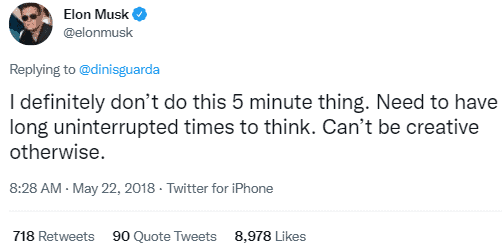How to Use Elon Musk Time Blocking Method to Maximize Your Productivity
Ever wondered how Elon Musk, CEO of SpaceX and Tesla, manages to accomplish so much in a single day?
It might seem like he’s defying the laws of time, but the secret behind his incredible productivity is a simple technique known as ‘Time Blocking‘. This is not a distant concept, but a practical tool that we can all incorporate into our routines to achieve more.
Musk breaks his day into bite-size increments, maximizing every single moment. From launching rockets to running multiple billion-dollar companies, he meticulously plans and executes his actions, making every second count.
He divides his day down to the minute, allocating every chunk of his time to a specific task or activity. This rigorous time management strategy helps him stay focused, and the result is there for all to see in his staggering productivity and achievements.
You might be thinking, “That’s Elon Musk, but can I do it?”
Absolutely. Elon Musk time blocking method isn’t some arcane knowledge reserved for the super-rich. Anyone willing to devote time and discipline can adopt it.
We’re going to dive deep into how you can make this method work for you, learning from the master himself.
After all, time is the one resource we all have equally – it’s about making the most out of every second.
Ready to power up your productivity? Let’s get started!
How does Elon Musk Time Blocking Method Work?
Time blocking is a straightforward yet highly effective time management method.
In a nutshell, it’s all about planning your day in advance, dividing it into small “blocks” of time, each allocated to a specific task. Think of it like a school timetable, but for life and work.
The 5-minute time-blocking method is often linked to Elon Musk, although he has denied using it (more on that later).
This method involves breaking your day into small, 5-minute blocks of time, with each block dedicated to a specific task or activity.
The practice of scheduling tasks in brief intervals serves as a means to condition the mind to concentrate on a single task, even if only for a brief duration.
The 5-Minute Rule Vs. Pomodoro
This might remind you of another time management technique – the Pomodoro Technique. They’re similar, but there’s a key difference.
Pomodoro typically uses 25-minute blocks, followed by a 5-minute break. In contrast, the 5-minute rule involves smaller, more frequent shifts between tasks. This helps avoid monotony and keeps you constantly engaged.
Why Time Blocking Matters
Time Blocking does more than just keep you organized. It’s a powerful time management method that transforms the way you work. Successful CEO such as Bill Gates also advocates its effectiveness. By blocking time on your daily schedule, you can:
Plan Each Task Ahead
Pre-planning tasks allows you to reflect on the time each task requires and dedicate a specific amount of time to it.
Avoid Procrastination
Time Blocking forces you to concentrate on the task at hand, reducing the chances of getting sidetracked.
Stay Focused and Productive
By allocating fixed periods for specific tasks, you’re less likely to exhaust your mental resources on one task.
Balance Work and Rest
Just like Musk’s 5-minute rule, time blocking affirms the importance of taking breaks. It’s not just about relentless focus, it’s about balanced productivity.
As we mentioned earlier, Elon Musk dismissed the idea of managing his time in five-minute blocks.
In his tweet to Dinis Guarda, Musk was clear – he needs more than five minutes to dive deep and do remarkable things.

Elon Musk prefers to invest his energy and focus in a concentrated manner on the things he’s truly passionate about. So, while the five-minute method might work for some, Musk clearly doesn’t buy into it. But remember, he didn’t totally reject the idea of time blocking.
He might be using a modified version, but with longer timeframes that suit his productivity style better.
5 Easy Steps to Time Blocking
Elon Musk’s 5-Minute Time Blocking Method may be too intense for most people, but you can adapt this concept into a more manageable version that suits your needs.
Here are five easy steps to implement Musk’s time blocking technique for everyday use:
1. Set Your Priorities
Identify your most important tasks and responsibilities for the day. These should be tasks that align with your long-term goals and have a significant impact on your life or work.
2. Allocate Time Blocks
Divide your workday into larger time blocks, such as 30 minutes or 1-hour intervals, instead of 5-minute increments. This provides more flexibility and reduces the pressure of constant scheduling.
3. Assign Specific Tasks
Within each time block, assign specific tasks or activities. Be realistic about what you can accomplish in that time frame. For example, you might allocate a block for email responses, a block for a project, and a block for a meeting.
4. Minimize Distractions
During each time block, minimize distractions. Turn off unnecessary notifications, close irrelevant browser tabs, and create a focused work environment. Use a timer to work in concentrated bursts with short breaks in between.
5. Review and Adjust
At the end of each time block or at the end of the day, review your progress.
Did you accomplish what you intended? Adjust your schedule for the next day based on what you learned. Over time, you’ll become better at estimating how long tasks take and optimizing your time management.
Different Ways to Time Blocking

Time Blocking with Pen & Paper
Using a pen and ruled paper for time blocking is a simple yet effective time management method.
Divide your ruled paper into two columns, with the left column allocated for your time blocks and the corresponding right column for the important tasks to be done in those respective time blocks.
Remember to add commentary notes beside each task for extra room and detail. This method forces you to stay focused and stay productive by committing to specific tasks during set times.
If you’re not a fan of creating your own layout, there are printable templates available online that can simplify the process. These templates often include sections for time blocking, specific tasks, and even a space for highlighting your most important tasks for the day.
Digital Solutions for Time Blocking
As for digital solutions, Google Calendar, Google Sheets, and Notion are excellent tools for time blocking.
I’m a big fan of Time Blocking with Google Calendar since it syncs across my devices, letting me check my schedule on the go. This time management technique is incredibly handy for attending meetings, business meetings, and even managing your personal hobbies.
Google Sheets is excellent for those who appreciate the flexibility of spreadsheets. You can color-code your tasks, add notes, and adjust things easily.
Notion, on the other hand, can be customized to your liking. It reduces stress from unexpected interruptions and helps sustain a daily routine.
Applying the Time Blocking Method
Let’s translate this into a relatable work scenario. Imagine you’re a project manager overseeing a new software launch. Instead of juggling tasks haphazardly, you embrace Musk’s time blocking method.
First, you map out your day, accounting for meetings, brainstorming sessions, and individual work time. For instance, you might set aside 8:00-9:00 AM for responding to emails and catching up on updates, 9:00-10:00 AM for a team meeting, and 10:00-12:00 PM for focused work on the project. After lunch, you dedicate 1:00-3:00 PM to reviewing and giving feedback on the team’s progress, 3:00-4:00 PM for planning next steps, and 4:00-5:00 PM for wrapping up and preparing for the next day.
By adhering to these self-imposed blocks, you’re able to stay on track and prioritize tasks effectively, even in the face of random interruptions. It also facilitates a healthy balance between individual tasks and collaborative effort. There’s no room for procrastination as each task has its designated time.
Final Thoughts
Perhaps most importantly, time blocking allows you to protect your time. You can set aside time for deep, uninterrupted work – a precious commodity in today’s fast-paced, distraction-filled world. When your team members see time blocks on your calendar, they know when they can interrupt you and when they should let you focus.
In essence, time blocking gives structure to the whirlwind of tasks that a busy individual like you might face. It’s a simple, yet powerful tool to promote productivity, focus, and balance.
If you’re looking to learn more about Elon Musk’s time management techniques, watch this video.






